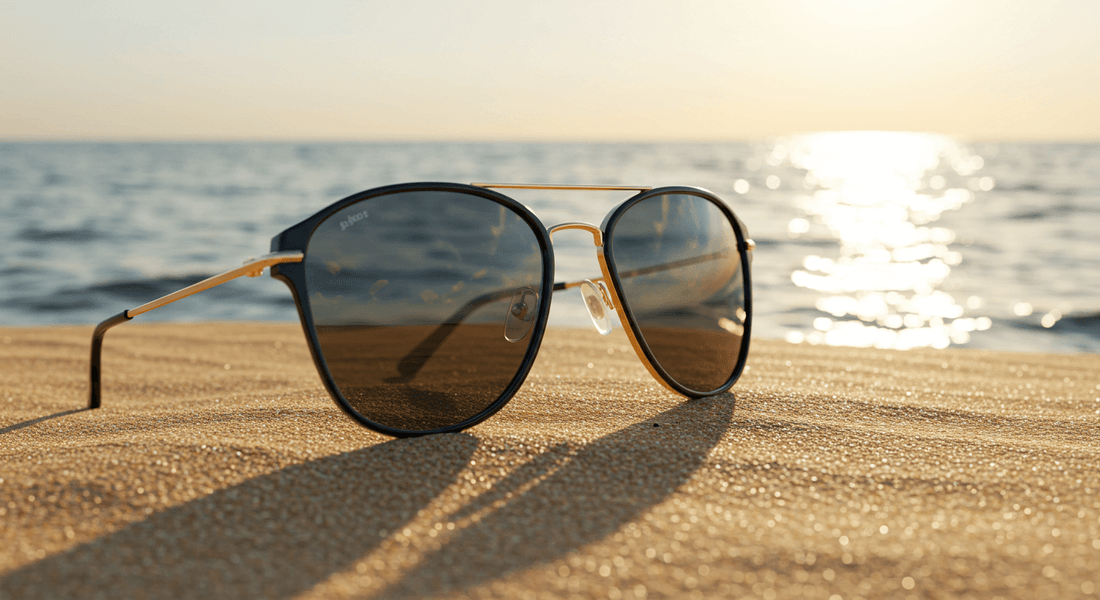
How Sunglasses Keep Your Eyes Healthy: Expert Tips for 2025
Share
Introduction
How sunglasses keep your eyes healthy is an essential topic for 2025, as awareness grows about the intersection of eye health, UV protection, and sustainability. More than just a fashion accessory, sunglasses play a critical role in preserving healthy vision by protecting against harmful rays and reducing eye strain. This guide explores how to choose the best sunglasses for healthy eyes, the benefits of wearing them daily, and the emerging trends that combine style, technology, and eco-consciousness to promote optimal eye health.
The Ultimate Guide to Choosing the Best Sunglasses for Healthy Eyes in 2025
How sunglasses protect healthy eyes: Understanding UV protection and glare reduction
Sunglasses serve as a vital barrier against ultraviolet (UV) radiation, a proven risk factor for eye diseases such as cataracts and macular degeneration. UV rays, specifically UVA and UVB, penetrate the cornea and lens, gradually damaging delicate eye tissues. Understanding how sunglasses protect healthy eyes means recognizing their capacity to effectively block these harmful rays. Modern sunglasses provide UV400 protection, ensuring nearly 100% filtration of UVA and UVB light—this level of defense is critical for maintaining long-term eye health.
In addition to UV protection, glare reduction technology plays a key role in eye comfort and safety. Glare from surfaces like water, snow, and roads causes eye strain and fatigue, impairing clarity and comfort. Polarized sunglasses benefit healthy eyes by filtering out reflected light, reducing discomfort, and improving visual precision. By combining UV protection and glare reduction, sunglasses provide comprehensive defense, preventing photokeratitis (sunburn of the eye) and supporting healthy vision throughout the day.
Choosing sunglasses for healthy eyes: Key features to look for including polarized and UV400 lenses
When selecting sunglasses for healthy eyes, several features must be prioritized. The best sunglasses should always include:
- UV400 lenses that block 99-100% of UVA and UVB rays.
- Polarized lenses to reduce glare and enhance visual comfort.
- Blue light filtering technology to protect against digital eye strain.
- Photochromic lenses that adjust tint according to ambient light for versatile protection.
- Adequate lens size and frame coverage to shield eyes from peripheral UV exposure.
These features not only support eye health but also ensure comfort during prolonged outdoor exposure. Additionally, selecting frames that fit securely and comfortably makes wearing sunglasses a sustainable habit that encourages regular use. The increasing demand for sunglasses that combine these features with stylish and sustainable materials demonstrates that consumers are prioritizing function and fashion.
Sunglasses healthy eyes tips: Balancing style, technology, and sustainability for everyday wear
In 2025, sunglasses healthy eyes tips highlight the importance of balancing aesthetic appeal with advanced technologies and eco-friendly materials. Effective daily use of sunglasses is most successful when users embrace options that incorporate health monitoring features—such as lenses that track UV exposure or adapt to changing environments. Sustainable eyewear crafted from recycled plastics, biodegradable acetate, or plant-based materials not only reduces environmental impact but also promotes eye comfort by minimizing weight and heat absorption.
Style remains a significant factor, encouraging consistent use. Investing in versatile, timeless designs aligned with individual lifestyle needs ensures sunglasses become a staple accessory. Integrating style, advanced lens technology, and sustainability empowers users to maximize the benefits of sunglasses for healthy eyes daily.
Why Wearing Sunglasses Is Essential for Eye Protection and Healthy Vision
Sunglasses and eye health: Preventing cataracts, macular degeneration, and other UV-related conditions
Long-term exposure to ultraviolet radiation is a leading cause of severe eye health issues. Wearing sunglasses significantly reduces the risk of developing cataracts, macular degeneration, and photokeratitis. Cataracts cloud the lens, impairing vision, while macular degeneration destroys the retina's central region, essential for sharp sight. Both conditions worsen with UV exposure.
Sunglasses and eye health are interlinked because quality lenses block UV radiation that accelerates these diseases. By consistently wearing sunglasses with certified UV protection, individuals safeguard their eyes' delicate structures, ensuring their vision remains clear and healthy over time.
Benefits of wearing sunglasses for healthy eyes even on cloudy and high-glare days
Many people mistakenly believe sunglasses are only necessary in bright sunlight. However, UV rays penetrate cloud cover, making sunglasses essential year-round. Additionally, glare reflected from snow, water, and pavement can cause eye strain and discomfort even on overcast days.
Wearing sunglasses reduces glare-induced headaches and prevents cumulative UV damage that occurs silently. This preventive measure improves overall eye comfort, enhances visual acuity, and protects against long-term complications. Incorporating sunglasses into your daily routine supports sustained healthy vision regardless of weather.
The role of polarized sunglasses healthy eyes: Enhancing visual comfort and reducing digital eye strain
Polarized sunglasses are specifically designed to target glare from horizontal surfaces such as water and roads, which ordinary tinted lenses cannot block effectively. This glare reduction minimizes eye strain, reduces squinting, and improves contrast perception—particularly crucial in activities like driving or outdoor sports.
Beyond glare, polarized lenses combined with blue light filtering protect against digital eye strain caused by prolonged screen exposure. The benefits of sunglasses for healthy eyes increasingly include these features as digital device usage rises, underscoring their importance in comprehensive eye protection and comfort.
Top Trends in Sunglasses for Eye Health: From Blue Light Blocking to Smart Technology
Sunglasses UV protection healthy eyes: Innovations like photochromic lenses and blue light filtering
In 2025, innovations in sunglasses UV protection focus on adaptive technologies such as photochromic lenses that darken or lighten based on lighting conditions. This allows users to maintain continuous UV protection indoors and outdoors without switching eyewear.
Blue light filtering sunglasses have become essential for combating the rise of digital eye strain from prolonged exposure to screens emitting high-energy visible light. These lenses filter harmful blue light wavelengths, preventing discomfort and reducing the risk of retinal damage while complementing traditional UV protection.
Smart sunglasses with health tracking: The future of personalized eye care and protection
Smart sunglasses with health tracking represent the forefront of eye care technology. These wearable devices integrate sensors that monitor UV exposure, track blink rates, and analyze environmental factors to deliver personalized eye health recommendations. Connected via apps, they can alert wearers when UV exposure exceeds safe limits or suggest breaks to reduce digital strain.
This innovation merges fashion, technology, and preventive care, empowering individuals to maintain healthy eyes proactively and tailor protection based on their lifestyle.
Sustainable eyewear and eco-friendly frames: How choosing green options supports healthy eyes
Sustainable eyewear is more than a trend—it is essential for promoting healthy eyes in 2025. Eco-friendly frames made from recycled or biodegradable materials not only minimize environmental impact but also provide increased comfort. Lightweight frames reduce pressure on the nose and ears, minimizing irritation, which indirectly benefits eye comfort and wearability.
Supporting sustainable brands encourages improvements in manufacturing processes and offers consumers an ethical choice that aligns with both eye health and environmental responsibility.
Sunglasses Benefits for Healthy Eyes: Expert Tips and Evidence-Based Insights for 2025
Sunglasses for eye protection: Understanding industry standards and certifications for maximum UV defense
To maximize sunglasses benefits, consumers should seek products that meet recognized industry standards such as ANSI Z80.3, ISO 12312-1, or CE certification. These ensure lenses provide effective UV protection and durability. The label “UV400” guarantees coverage of UVA and UVB light up to 400 nanometers, an important benchmark for eye safety.
Being informed about these certifications helps consumers avoid misleading marketing and choose sunglasses that genuinely protect their eyes against harmful radiation.
Common challenges with non-certified sunglasses and how to avoid risks to your eye health
Wearing substandard or non-certified sunglasses poses risks, as some lenses may reduce visible light but fail to block UV rays adequately. This can cause pupils to dilate in response to darkness, allowing more UV radiation to enter the eye and increase damage risk.
Avoiding these pitfalls requires purchasing sunglasses from reputable brands and verifying UV protection claims. Investing in the best sunglasses for healthy eyes is a straightforward step to prevent accidental harm and maintain long-term vision wellness.
How healthy eyes and sunglasses together reduce reliance on corrective lenses and improve overall vision wellness
Consistent use of sunglasses for eye health can slow vision deterioration by minimizing UV-related damage and digital strain, potentially reducing the need for corrective lenses over time. Protecting eyes from environmental hazards preserves natural lens clarity and retinal function, contributing to healthier vision as you age.
Additionally, advanced sunglasses technologies can complement corrective prescriptions or reduce symptoms such as photophobia, enhancing daily comfort and overall wellness.
FAQ
Why are sunglasses important for maintaining healthy eyes?
Sunglasses protect your eyes from harmful UVA and UVB rays, which can cause cataracts, macular degeneration, and other serious eye conditions. They also reduce glare, prevent photokeratitis, and help maintain healthy vision as you age.
What features should I look for in the best sunglasses for healthy eyes?
Choose sunglasses that block 99-100% of UVA and UVB rays, have polarized lenses to reduce glare, and, if possible, include blue light filtering to combat digital eye strain. Look for UV400 protection and consider photochromic lenses for adaptable tint.
Can wearing sunglasses protect my eyes on cloudy or overcast days?
Yes. UV rays can penetrate clouds, and glare from surfaces like water or snow can still harm your eyes. Wearing sunglasses with proper UV protection on such days helps preserve eye health and comfort.
How do polarized sunglasses benefit healthy eyes compared to regular sunglasses?
Polarized lenses reduce glare from reflective surfaces, enhancing visual clarity and comfort. This helps reduce eye strain and protects your eyes from overexposure, especially in high-glare environments like driving or near water.
Are sustainable and smart sunglasses effective for eye health in 2025?
Yes, sustainable eyewear offers eco-friendly materials that can improve comfort, while smart sunglasses incorporate health tracking and advanced filters, providing personalized protection and helping maintain healthy eyes with modern technology.
Conclusion
Sunglasses in 2025 are more than a fashion statement; they are a vital tool for safeguarding eye health through advanced UV protection, glare reduction, and emerging technologies like blue light filtering and smart health tracking. By choosing sunglasses that combine certified UV400 lenses, polarized technology, and sustainable materials, individuals can protect their vision from serious conditions such as cataracts and macular degeneration while enjoying greater comfort and style. Embracing these expert tips and innovations ensures that wearing sunglasses becomes an indispensable part of daily wellness, enabling healthier vision for years to come.
